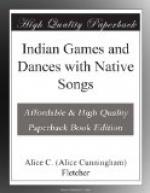Every Indian dance has a meaning. The dance is generally either the acting out of some mythic story or a presentation of a personal experience. Every movement of the body, arms, hands, feet and head is always in strict time with the songs that invariably accompany the dance. Indian dances are complex rather than simple. Their “spontaneous activity” is not the result of “a dominating emotion” but of a desire to present dramatically certain mental pictures. This is particularly true of dances which form a part of religious ceremonials. As a consequence, none of these dances are improvised. All follow forms that have been handed down through generations and have become more or less conventionalized.
When the dance portrays a personal experience the dancer is allowed a freedom of invention not elsewhere permitted. Even in this case the dancer is obliged to follow certain conventional forms, as in the sign language; otherwise his story would not be understood.
On the eastern continent the peoples from whom we are descended had songs and dances peculiar to their different vocations, so on this western continent the song and dance were the accompaniment of the Native industries.
A study of the Indian dramatic dances shows that by means of them the vocations of men and women were lifted out of drudgery, made types of activity and allied to the forces recognized in the religious beliefs of the people. The dances here given, those relative to the Corn and also the Hede-wache, not only illustrate what has been said above but they reflect back a light upon the religious dances that obtained among the eastern nations of antiquity.
When the Indian dances, he dances with freedom; his whole body becomes expressive of the actuating emotion of the scene he intends to portray. Because of his freedom, his remarkable sense of rhythm and the strong mental picture he aims to present, whether it be the flight of the eagle, the sportive pleasure of birds, the movements of animals, the alertness of the warrior in attack, or in eluding a blow, his motions are always sharply vivid and natural.
It is a pleasure to be able to offer in the following pages a number of Indian songs with their original accompaniment of action, as the two complement each other for the expression of certain native thoughts and aspirations.
Whoever takes part in the dances here presented should never attempt to imitate what is supposed to be the Indian’s manner of singing or his dancing steps and postures; in either case the result would probably be an unmeaning burlesque. Each dancer should have a clear mental picture of the scene to be enacted and then give free play to bodily movements for its expression, always keeping in rhythm with the song, so as to make sound and motion a rhythmic unit.
THE LIFE OF THE CORN
A DRAMA IN FIVE DANCES




